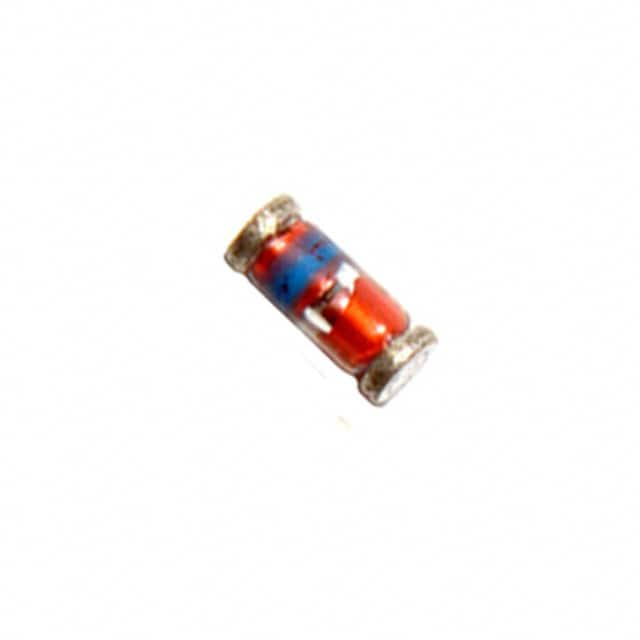Viz Specifikace pro podrobnosti o produktu.

BAV103-TP
Introduction
The BAV103-TP is a diode belonging to the category of small signal Schottky diodes. This entry provides an overview of the basic information, specifications, pin configuration, functional features, advantages and disadvantages, working principles, application field plans, and alternative models of the BAV103-TP.
Basic Information Overview
- Category: Small Signal Schottky Diode
- Use: The BAV103-TP is commonly used in high-frequency applications, such as mixers, detectors, and clippers.
- Characteristics: It exhibits low forward voltage drop and fast switching capabilities.
- Package: SOD-123 package
- Essence: The diode is designed for high-speed switching applications.
- Packaging/Quantity: Available in tape and reel packaging with quantities varying based on supplier.
Specifications
- Forward Voltage: 0.55V at 1A
- Reverse Voltage: 40V
- Maximum Continuous Forward Current: 200mA
- Reverse Recovery Time: 4ns
- Operating Temperature Range: -65°C to +125°C
Detailed Pin Configuration
The BAV103-TP has two pins: 1. Anode (A) 2. Cathode (K)
Functional Features
- Fast Switching Speed: Enables rapid response in high-frequency applications.
- Low Forward Voltage Drop: Minimizes power loss during operation.
- High Reverse Voltage: Provides protection against reverse voltage conditions.
Advantages and Disadvantages
Advantages
- Fast switching speed
- Low forward voltage drop
- High reverse voltage capability
Disadvantages
- Limited maximum continuous forward current
- Sensitive to temperature variations
Working Principles
The BAV103-TP operates based on the Schottky barrier principle, where the metal-semiconductor junction allows for faster switching compared to standard PN-junction diodes. When forward biased, it allows current to flow with minimal voltage drop, making it suitable for high-frequency applications.
Detailed Application Field Plans
The BAV103-TP finds extensive use in the following applications: - RF Mixers - RF Detectors - Clipping circuits in high-frequency systems
Detailed and Complete Alternative Models
Some alternative models to the BAV103-TP include: - BAT54S: Similar characteristics and package type - HSMS-286x: Higher reverse voltage and lower forward voltage drop - 1N5711: Lower reverse recovery time and higher maximum continuous forward current
In conclusion, the BAV103-TP is a small signal Schottky diode with fast switching speed, low forward voltage drop, and high reverse voltage capability. Its application spans across various high-frequency circuits, and there are alternative models available with different specifications to suit specific requirements.
[Word Count: 410]
Seznam 10 běžných otázek a odpovědí souvisejících s aplikací BAV103-TP v technických řešeních
Sure, here are 10 common questions and answers related to the application of BAV103-TP:
What is BAV103-TP?
- BAV103-TP is a high-speed switching diode array with two diodes connected in series.
What are the typical applications of BAV103-TP?
- BAV103-TP is commonly used in high-speed switching, general-purpose rectification, and protection circuits.
What is the maximum forward voltage of BAV103-TP?
- The maximum forward voltage of BAV103-TP is typically around 1V at a forward current of 100mA.
What is the reverse breakdown voltage of BAV103-TP?
- The reverse breakdown voltage of BAV103-TP is typically around 75V.
What is the maximum forward current of BAV103-TP?
- The maximum forward current of BAV103-TP is typically around 200mA.
Is BAV103-TP suitable for high-frequency applications?
- Yes, BAV103-TP is designed for high-speed switching applications and is suitable for high-frequency use.
Can BAV103-TP be used for voltage clamping?
- Yes, BAV103-TP can be used for voltage clamping and transient suppression in electronic circuits.
What is the package type of BAV103-TP?
- BAV103-TP is typically available in a SOT-23 surface mount package.
Does BAV103-TP have any special handling requirements?
- BAV103-TP should be handled using standard ESD precautions to avoid damage during assembly and use.
Are there any recommended alternative components to BAV103-TP?
- Some alternative components to BAV103-TP include BAV102-TP, BAV104-TP, and BAV199-TP, which offer similar characteristics for different design considerations.

